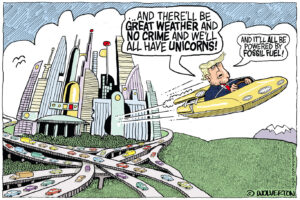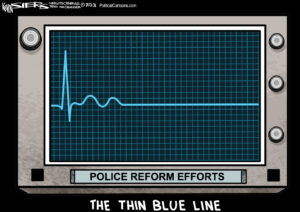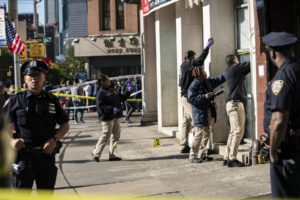When Your Boss Turns Out to Be a Serial Killer
Examining serial killers past and present and how marginalized groups tend to be their most likely victims. Crime scene tape. (Photo: Flickr/DPP Law/cc)
Crime scene tape. (Photo: Flickr/DPP Law/cc)
When Mary Shell, a 40-year-old TV show producer, saw the headlines about her old boss, Rex Heuermann, she practically thought she was hallucinating. Heuermann was the head of a prominent, Manhattan-based architecture firm where Shell had spent a few years ferrying paperwork in her 20s and he had just been arrested in connection to corpses found in Gilgo Beach, Long Island.
“It was so surreal that it felt unreal,” she tells Truthdig, and she thought that “Maybe it’s someone with the same name as him?”
But the mugshot confirmed that her former boss was the prime suspect in a series of murders that had flummoxed law enforcement for decades.
Between 1996 and 2011, 11 bodies were found buried in Gilgo Beach. In that time, investigators with the Suffolk County Police Department made little headway. The victims who were identified had worked as escorts, which some observers suggest didn’t inspire urgency within the department. Robert Kolker, who wrote the 2013 book “Lost Girls: An Unsolved American Mystery,” recently wrote: “If the victims had been successful and well-educated, like the victims of David Berkowitz, the serial killer known as Son of Sam, all of Long Island might need to be in a panic,” he writes. “But everyone could relax. Sex workers didn’t seem to deserve the same consideration.” TMZ reports that the police chief, James Burke, himself frequented escorts. Burke was arrested this week for attempting to solicit a sex act.
None of the former co-workers she spoke with had ever had suspicions that the suburban father from Long Island was murdering women in his off time.
Heurmann is charged in the murders of Megan Waterman, Melissa Barthelemy and Amber Costello. He was also named as the prime suspect in the murder of the fourth of the “Gilgo Four,” Maureen Brainard-Barnes. He hasn’t been charged for the other bodies — they remain unidentified Jane Does, as well as a baby and an unidentified Asian man — but criminologists have suggested that he’s responsible for more murders and police are looking for bodies at his property in Las Vegas.
His victims were often single mothers scrapping for rent or dealing with other challenges.
Waterman had a three-year-old daughter. Brainard-Barnes, too, was the mother of a young girl, and had turned to sex work to support her child. Costello’s heroin addiction ensnared her into sex work.
Shell describes Heurmann as an awkward nerd who blushed the first time she walked into his office. None of the former co-workers she spoke with had ever had suspicions that the suburban father from Long Island was murdering women in his off time. “He just had this harmless vibe,” she recalls.
But in hindsight, she thinks it’s telling that her former boss’s other hobby was hunting animals in exotic locales. “He used the same strategy — patience, tracking — from hunting trips in Alaska and Africa to hunt women,” she says.
Cases like Heurmann’s — a killer stalking multiple victims over weeks, months or even years have been on the decline since their peak in the 1970s, 1980s and 1990s. According to the Florida Coast University’s Serial Killer Database, in 1987, there were 198 known active serial killers. By 2018, the database reports only 12 known serial killers and 44 victims.
Thomas Hargrove, a journalist and founder of the Murder Accountability Project, tells Truthdig that now there tends to be earlier interventions in mental health treatment, when signs of sociopathy, like torturing animals, come up in childhood. Forensic DNA evidence also makes it more difficult for perpetrators to stay under the radar. But, mostly, the surveillance machines we carry on our person at all times make it harder for a perpetrator to avoid detection or for a victim to vanish off the face of the earth.
At the same time serial killings appear to have gone down, we’ve seen a dramatic rise in mass shootings — there were 100 by March of 2023.
“Mass shooters, it’s about a teen’s pain. They want to get it out and take out as many people with them,” Laura Brand, a forensic psychiatrist who has interviewed more than 50 murderers, tells Truthdig. “A serial is way more calculated. They like the hunt, watching victims. Getting away with it.”
Despite their decline in number and visibility, Brand is not optimistic that humanity has evolved past serial murder, though she agrees there’s been a decline, mostly due to surveillance technology.
One foreboding possibility is that serial killers have shifted their strategies to evade detection. “You might be seeing a shift to rural areas that aren’t as heavily surveilled as urban centers,” she says. “And there are some parts where you don’t have such regular cell service where your location might not be tracked as well.”
In her research, Brand has also observed that police are more likely to block their scanners in serial killer investigations, cutting out the role of media in its frenetic appetite for “if it bleeds it leads” coverage. “Serial killing inspires such fear, they want to keep in more hush hush from the media.”
It could be too, that serial killings, like other homicides, are not getting solved as much. Homicide clearance rates have dropped from about 90% in 1960 to 50% today (although this could also be due to better data collection by institutions like the FBI-UCR database, that collects numbers from departments around the country).
“The big question is: Are they going underground and finding other techniques?” Terence Leary, team leader for the Florida Gulf Coast University’s Serial Killer Database, told The New York Times.
The term “serial killer” derives from the German term “Serienmorder” coined by a Berlin investigator Ernst Gennat during the Weimar Republic of pre-World War 11 Germany. It was a deeply turbulent era noted for several high-profile serial killings (not to mention the rise of Hitler), inspiring the classic movie, “M,” starring Peter Lore, which centers on a child killer known for his chilling whistle.
Obviously, people have sadistically murdered other people since the dawn of time. But serial killers, as we know them, are often considered a product of modernity. During the industrial revolution, the narrative goes, urbanization and loosening social ties made killing strangers, and getting away with it, easier. “The rise of capitalism and related processes of mass migration to urban centers resulted in individuals being immersed in a sea of strangers,” writes sociologists Kevin Haggerty and Ariane Ellerbrok in The Social Study of Serial Killers.
At the same time, the emergence of mass media — and its profit motives — catapulted the figure of the serial killer into the public consciousness, reflecting back the fears of the rapid social and economic changes of the 19th and 20th centuries.
Take Jack the Ripper, who continues to occupy a large swath of the cultural imagination: there was a movie, “Ripper’s Revenge,” released just this year, two centuries after the bodies of prostitutes surfaced in the slums of East London in 1888, with their throats slashed and internal organs cut out. The dead women spawned breathless news accounts. The media frenzy generated false confessions, with one letter being highly suspected to have been ghost-written by reporters to increase their newspapers’ circulation.
Serial killings, while they may seem random, also reflect back the social and economic inequalities in modern life: victims are almost always from disadvantaged groups.
A flip side to the anonymity of modern life is the desire for celebrity. As criminologist Steven Egger writes in “The Killers Among Us”, the most notorious serial killers “seemed to enjoy their celebrity status and thrive on the attention they received.” ‘‘How many times do I have to kill before I get a name in the paper or some national attention?’” one murderer apparently griped to local police, according to Egger’s research.
In the U.S. in the 1970s, 1980s, and 1990s, killers like David Berkowitz, the Boston Strangler, Ted Bundy, Jeffrey Dahmer and John Wayne Gacy terrorized regions of the country and made national news. In his book, “Serial Killers and Media Circuses,” Dirk C. Gibson posits complex relationships between the media, law enforcement and serial killers that “affect all salient stakeholders.” He notes that “Media coverage of serial murders influences the killer, media coverage influences the serial murder investigation, and serial killers and murder cases influence the media.”
Serial killings, while they may seem random, also reflect back the social and economic inequalities in modern life: victims are almost always from disadvantaged groups. Sex workers, the elderly, homeless people and children. Predators commonly prey on the marginalized because society’s lack of concern gives them a better chance of getting away with it.
Samuel Little, a Black man considered the most prolific serial killer in U.S. history, has confessed to 93 murders between 1970 and 2005. His victims were Black women. “For many years, Samuel Little believed he would not be caught because he thought no one was accounting for his victims,” said Crime Analyst Christie Palazzolo in an FBI statement. Lonnie David Franklin Jr., known as the Grim Sleeper, also targeted Black women.
For Shell, it’s chilling to consider that, like the women Heurmann allegedly murdered, she too was diminutive and in her mid-20s when she worked with him for roughly three years. “I also weighed about 100 pounds,” Shell says, adding that Heurmann’s office was full of young women with small statures. Heurmann, meanwhile, towers at 6 feet, 4 inches.
The last time Shell had heard from Heurmann was 2010, around the time Costello disappeared. She remembers when the bodies were found and wonders if the only difference between her and the victims is that she never had to resort to sex work. “Is it specifically sex workers he hates? Or is it all women, as a group?”
Your support matters…Independent journalism is under threat and overshadowed by heavily funded mainstream media.
You can help level the playing field. Become a member.
Your tax-deductible contribution keeps us digging beneath the headlines to give you thought-provoking, investigative reporting and analysis that unearths what's really happening- without compromise.
Give today to support our courageous, independent journalists.






You need to be a supporter to comment.
There are currently no responses to this article.
Be the first to respond.